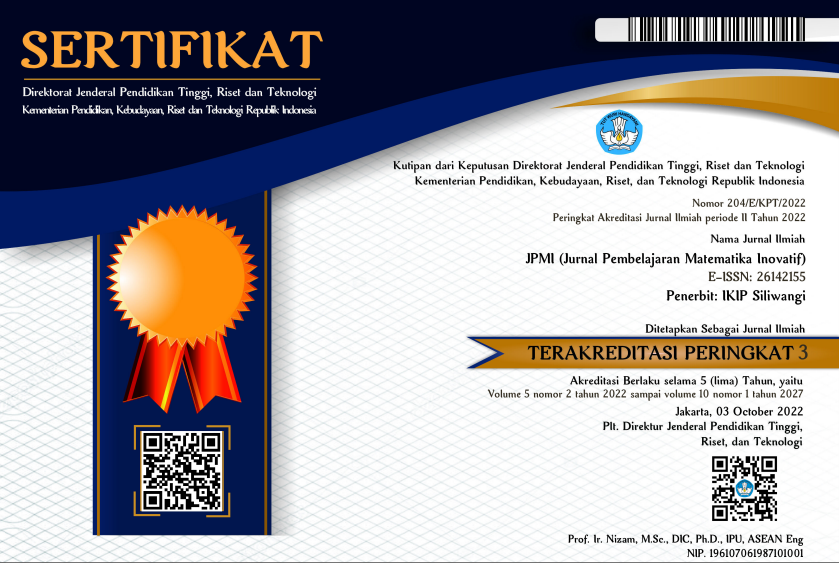Pengembangan media pembelajaran operasi aljabar berbasis articulate storyline berbantuan quizwhizzer untuk mendukung pemahaman konsep
DOI:
https://doi.org/10.22460/jpmi.v7i2.21306Keywords:
Learning Media, Articulate Storyline, Quizwhizzer Website, Algebra, Concept of UnderstandingAbstract
The purpose of this research are to describe the development process and result of algebra-based learning media by articulate storyline with help quizwhizzer website of valid, practical, and effective to support the student’s concept of understanding in algebra. This research model is ADDIE type, which has five steps, they are : analyse, design, development, implementation, and evaluation. Algebra-based learning media by articulate storyline with help quizwhizzer websitewas tested by two examinations, which are limited examination and direct examination to studenst of MTs Al-Mahrusiyah Lirboyo Kediri. The research tools used were validated papers, student’s and teacher’s assessment response, and the sheets of concept understanding. Algebra-based learning media by articulate storyline with hrlp quizwhizzer website has reached the validity percentage of 79,6%. The practical result showed the number 83%, previewed from studen’s assessment response. Therefore, it is valid to state that it has fulfilled the practical criteria. The effectiveness result showed 72% previewed from the result of student’s concept of understanding test. In addition to that, it has fulfilled the criteria effectively.
References
Akbar, S. (2013). Instrumen perangkat pembelajaran. Bandung : PT Remaja Rosdakarya.
Akhyar, M. K., & Firdaus, E. F. (2021). Pengembangan mioba (multimedia interaktif operasi bentuk aljabar) berbasis articulate storyline 3. Jurnal Dialekta Progrm Studi Pendidikan Matematika, 8(2), 680-696. https://journal.peradaban.ac.id/index.php/jdpmat/article/view/887/674
As’ari, A. R., Tohir, M., Valentino, E., Imron, Z., & Taufiq, I. (2017). Matematika Kelas VII SMP/MTs: Buku guru (edisi revisi). Pusat Kurikulum dan Perbukuan, Balitbang, Kemendikbud. https://repositori.kemdikbud.go.id/5247/1/b_ad78865b-d042-4e9d-b8a5-8bb86be48a2c.pdf
Blanton, M. L., & Kaput, J. J. (2005). Characterizing classroom practice that promotes algebraic reasoning. Journal for Research in Mathematics Education, 35(5), 412–446. https://mathed.byu.edu/kleatham/Classes/Fall2010/MthEd590Library.enlp/MthEd590Library.Data/PDF/BlantonKaput2005CharacterizingAClassroomPracticeThatPromotesAlgebraicReasoning-1974150144/BlantonKaput2005CharacterizingAClassroomPracticeThatPromotesAlgebraicReasoning.pdf
Branch, R. M. (2009). Instructional design : the addie approach. New York: Springer New York.
Dirgantara, I. W., Suyasa, P. W. A., & Mertayasa, I. N. E. (2023). Pengembangan media pembelajaran bangun ruang sisi datar berbasis articulat storyline 3 pada mata pelajaran matematika kelas viii di smp lab undiksha. (Kumpulan Artikel Mahasiswa Pendidikan Teknik Informatika) KARMAPATI, 12(1), 67–77. https://ejournal.undiksha.ac.id/index.php/KP/article/view/58851/25194
Faijah, N., Nuryadi, & Marhaeni, N. H. (2022). Efektivitas penggunaan game edukasi quizwhizzer untuk meningkatkan pemahaman konsep teorema phytagoras. PHI : Jurnal Pendidikan Matematika, 6(1), 117–123. http://dx.doi.org/10.33087/phi.v6i1.194
Hidayat, F., & Nizar, M. (2021). Model addie (analysis, design, development, implementation, and evaluation) dalam pembelajaran pendidikan agama islam. Jurnal Inovasi Pendidikan Agama Islam, 1(1), 28–37. https://doi.org/10.15575/jipai.v1i1.11042
Indriani, M. S., Artika, I. W., & Ningtias, D. R. W. (2021). Penggunaan aplikasi articulate storyline dalam pembelajaran mandiri teks negoisasi kelas x boga di smk negeri 2 singaraja. Jurnal Pendidikan Bahasa Dan Sastra Indonesia, 11(1), 25–36. https://doi.org/10.23887/jjpbs.v11i1.29316.
Kristanto, A. (2016). Media pembelajaran. Surabaya: Bintang Surabaya.
Milah, A. M., Susilawati, W., Widiastuti, T. T., & Ariany, R. L. (2022). Adaptasi Teknologi dalam pembelajaran matematika technology adaptation in mathematics learning. Gunung Djati Conference Series, 12, 73–79. https://conferences.uinsgd.ac.id/index.php/gdcs/article/view/714
Mulungye, Mary, M., O’Connor, Miheso, & Ndethiu. (2016). Sources of student errors and misconceptions in algebra and effectiveness of classroom practice remediation in machakos country kenya. Journal of Education and Practice, 7(10), 31–33. https://files.eric.ed.gov/fulltext/EJ1099568.pdf
Putri, O. O., & Roesdiana, L. (2023). Analisis kesalahan siswa pada materi aljabar ditinjau dari kemampuan pemahaman konsep matematis. Jurnal Pembelajaran Matematika Inovatif (JPMI), 6(2), 829–840. https://doi.org/10.22460/jpmi.v6i2.16905.
Rahman, I. M., Darmawan, P., & Prayekti, N. (2019). Analisis kesalahan siswa smp kelas vii dalam menyelesaikan soal operasi bentuk aljabar. Prosiding Seminar Nasional MIPA, 50–57. https://ejournal.unibabwi.ac.id/index.php/knmipa/article/download/816/554/
Riduwan, & Akdon. (2013). Rumus dan data dalam analisis statistika. Bandung: Alfabeta.
Wahyuningsih, F., Woroharsih, R. D., Saksono, L., & Samsul, S. . (2021). Utilization of Quizwhizzer educational game applications as learning evaluation media. Advances in Enginnering Research, 209, 148–152. https://www.atlantis-press.com/article/125966480.pdf
Widoyoko, E. P. (2017). Evaluasi program pembelajaran (Cetakan 9). Yogyakarta: Pustaka Pelajar.
Yahya, R., Ummah, S. K., & Effendi, M. M. (2020). Pengembangan perangkat pembelajaran flipped classroom bercirikan mini-project. SJME : Supremum Journal of Mathematics Education, 4(1), 78–91. https://doi.org/10.35706/sjme.v4i1.3136
Yanto, D. T. P. (2019). Praktikalitas Media Pembelajaran Interaktif pada Proses Pembelajaran Rangkaian Listrik. Invotek : Jurnal Inovasi Vokasional Dan Teknologi, 19(1), 75–82. https://doi.org/10.24036/invotek.v19vi1.409
Downloads
Published
Issue
Section
License

This work is licensed under a Creative Commons Attribution-ShareAlike 4.0 International License.
The author is responsible for acquiring the permission(s) to reproduce any copyrighted figures, tables, data, or text that are being used in the submitted paper. Authors should note that text quotations of more than 250 words from a published or copyrighted work will require grant of permission from the original publisher to reprint. The written permission letter(s) must be submitted together with the manuscript.
















